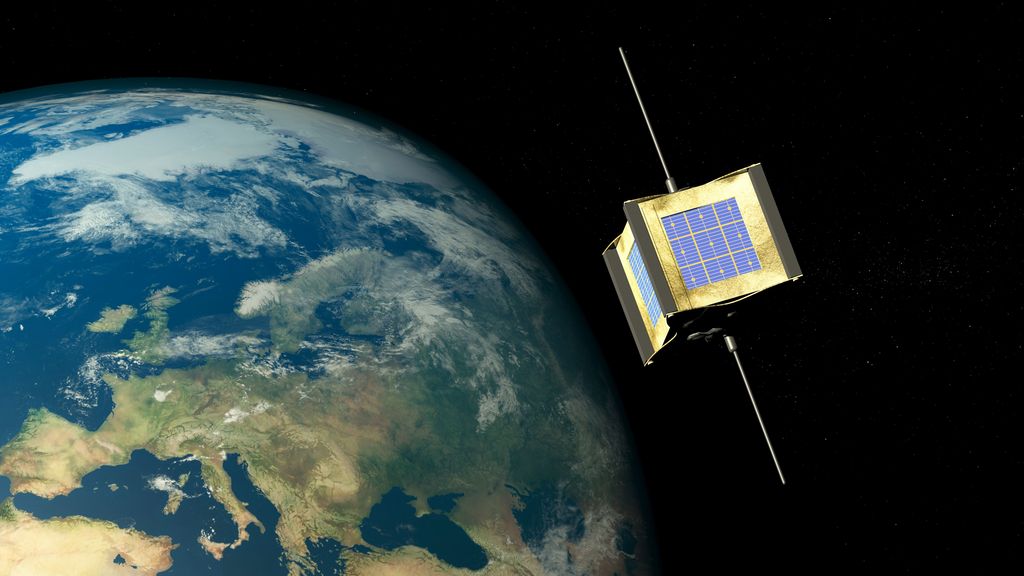COLOGNE, Germany, Aug. 29, 2022 — A German consortium composed of Q.ANT, Bosch, TRUMPF, and the German Aerospace Center (DLR) plans to use quantum technology to permanently enhance satellite measurement stability. Reliable transmission of satellite communication signals can only be achieved by constantly maintaining high-precision attitude control of satellites in their orbits. If a satellite moves out of position, the signals get weaker.
The partners will develop space-qualified attitude sensors in a project will improve internet access, particularly in remote regions, TRUMPF said in a press release. The aim is to use these quantum technology-based sensors to achieve high-precision attitude control of miniaturized satellites. The sensors’ ability to maintain precise orientation of the satellites in relation to each other will enable high-speed data connectivity.
Quantum sensors are particularly suitable for deployment in satellites since they provide reliably accurate measurement results and excellent performance in a compact, low-weight package. This solution can keep satellites correctly oriented in space over a period of years.
The DLR hopes to launch its first miniaturized satellites equipped with quantum technology in five years. “The goal of developing European quantum sensors is to achieve greater independence from the global market,” the press release said.
“This strategic partnership shows the tremendous potential that lies in the collaborative development of pioneering technologies,” said Michael Förtsch, CEO of Q.ANT. “The deployment of quantum technology in the aerospace industry is a huge opportunity for Germany as a major industrial hub.”
Beyond their use for satellites, attitude, and position, sensors that harness quantum effects can be used for autonomous driving systems and indoor navigation technologies in factories, logistics warehouses, and other facilities.
Q.ANT, which is a wholly owned subsidiary of TRUMPF, will lead the development project and develop the overall sensor concept. It is also responsible for integrating the various sensor components and keeping them in precise and stable alignment with each other to ensure they function smoothly and reliably in the satellite.

Sensors developed through a public-private collaboration will help satellite orientation and proper distancing, thereby ensuring better connectivity. Courtesy of TRUMPF.
Q.ANT. will also supply a very low-noise detection system.
Bosch researchers are working on the development of a miniaturized, space-qualified sensor cell. The measuring cell is filled with an atomic gas that is excited by laser beams and magnetic fields, which cause the atoms to spin. The rotation of the sensor causes changes in the rotational speed of this spin. This provides high-precision feedback on changes in the satellite’s attitude, thereby enabling more accurate attitude control.
“The measuring cell is the core component of the quantum sensor,” said Thomas Kropf, head of research at Bosch.
TRUMPF will contribute laser expertise from two of its German locations. TRUMPF Photonic Components in Ulm will supply the miniature laser diodes. These are used in smartphones, industrial optical sensors, and similar applications, and TRUMPF will now team with the Ferdinand-Braun Institut to prepare these robust beam sources for use in quantum technology and in space.
TRUMPF’s Berlin location combines the light sources from Ulm with additional measurement technology and then integrates the resulting system into miniaturized housings. The final product is temperature-stabilized to ensure it will withstand extreme conditions in space.
“I can see a tremendously bright future for our miniature lasers in a whole variety of new applications,” said Berthold Schmidt, CEO of TRUMPF Photonic Components. “This is the kind of government-funded project that gives Germany a real boost as a major hub of photonics expertise.”
The Galileo Competence Center at DLR is responsible for all space-related aspects. While ensuring that the system is space-qualified, it will also be in charge of the implementation, transportation, and operation of the satellite.
The project has a research budget of approximately €28 million ($27.93 million).